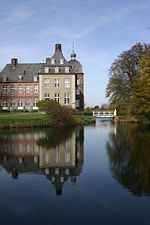Hovestadt
Hovestadt is a village in the municipality of Lippetal in the Soest district in North Rhine-Westphalia with 1217 inhabitants (as of December 31, 2007 ).
Besides the St. Albertus-Magnus church, Hovestadt is best known for the Hovestadt moated castle with its baroque garden .
geography
Hovestadt is located south of the Lippe opposite the village of Herzfeld (Lippetal) north of the Lippe in the outlet of the Soester Börde . Neighboring larger cities are Lippstadt 14 kilometers east, Hamm 18 km west, Beckum 13 km north and Soest 10 km south of Hovestadt. Coordinates: 51 ° 39 ' N , 8 ° 9' E
history
In 1939 there were 676 inhabitants in Hovestadt.
On July 1, 1969, Hovestadt was incorporated into the newly created municipality of Lippetal as part of the municipal reorganization.
In 2005 there were 1,250 inhabitants in Hovestadt.
Hovestadt Castle, which secures the transition over the Lippe, was first mentioned in a document in 1292. Due to its strategic location, the castle was destroyed and rebuilt several times during the Middle Ages . The castle , located as a moated castle directly on the Lippe, was built from 1563 to 1572 by the architect Laurenz von Brachum in the style of the Renaissance and over the years it has been repeatedly changed and expanded to its present form. The outer bailey was built by Johann Conrad Schlaun in 1733 . The baroque garden from the 18th century was reopened to the public after the restoration in 1997 and is now part of the garden route Münsterland of the European Garden Heritage Network . The Counts of Plettenberg have lived in the castle since 1733 .
Personalities
Sons and daughters of the place
- Johann Sigismund von der Heyden (1656–1730), Prussian general
- Bernhard von Plettenberg zu Lenhausen (* 1903; † 1987), sculptor
- Friedrich Christian von Plettenberg (1882–1972), winery owner
- Elmar Schenkel (born August 28, 1953 ), English scholar, writer and translator
- Hermann Windesheim (born March 5, 1838 , † April 4, 1905 in Nice ), German-Jewish industrialist and councilor
- Leon (* 1969 as Jürgen Göbel ) is a German pop singer
- Dirk Langerbein (* 1971) former soccer goalkeeper and current goalkeeping coach
Individual evidence
- ↑ Martin Bünermann: The communities of the first reorganization program in North Rhine-Westphalia . Deutscher Gemeindeverlag, Cologne 1970, p. 91 .
Web links
- Document requests from the Hovestadt Castle archive / digital Westphalian document database (DWUD)
- Official homepage of the municipality of Lippetal
- www.Hovestadt.de
- Felix Bierhaus Archive Hovestadt
- Regional Association of Westphalia-Lippe: Hovestadt Castle Park in LWL geodata culture
- Finding aids for the Hovestädter archive of the Counts of Plettenberg-Lenhausen


